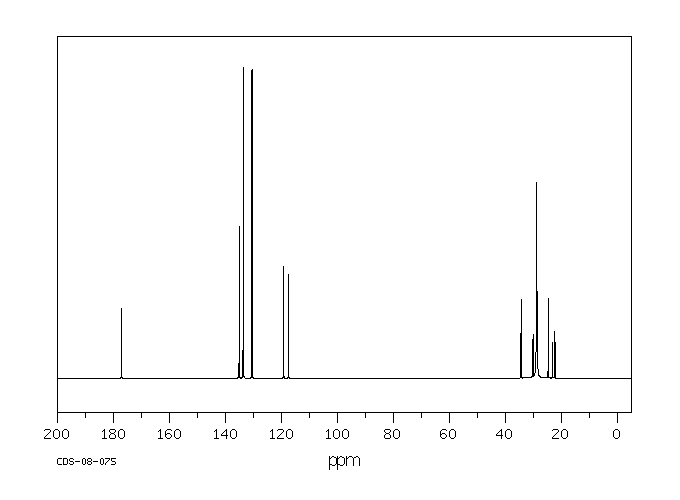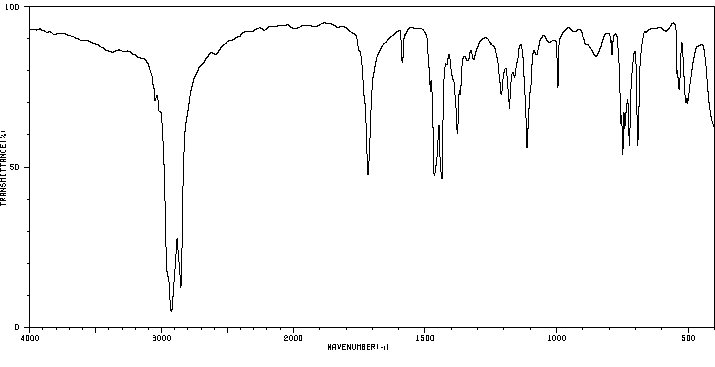(10-carboxydecyl)triphenylphosphonium bromide | 7530-96-3
中文名称
——
中文别名
——
英文名称
(10-carboxydecyl)triphenylphosphonium bromide
英文别名
11-Triphenylphosphaniumylundecanoate;hydrobromide
CAS
7530-96-3
化学式
Br*C29H36O2P
mdl
——
分子量
527.481
InChiKey
WNFYJWNAWIJMEL-UHFFFAOYSA-N
BEILSTEIN
——
EINECS
——
-
物化性质
-
计算性质
-
ADMET
-
安全信息
-
SDS
-
制备方法与用途
-
上下游信息
-
文献信息
-
表征谱图
-
同类化合物
-
相关功能分类
-
相关结构分类
物化性质
-
熔点:103-105 °C
计算性质
-
辛醇/水分配系数(LogP):3.58
-
重原子数:33
-
可旋转键数:14
-
环数:3.0
-
sp3杂化的碳原子比例:0.34
-
拓扑面积:37.3
-
氢给体数:1
-
氢受体数:3
安全信息
-
储存条件:室温
SDS
反应信息
-
作为反应物:描述:(10-carboxydecyl)triphenylphosphonium bromide 在 palladium on activated charcoal 吡啶 、 sodium hydroxide 、 氢气 、 sodium methylate 、 sodium hexamethyldisilazane 、 对甲苯磺酸 、 二氯磷酸苯酯 、 pyridinium chlorochromate 作用下, 以 甲醇 、 乙醚 、 二氯甲烷 、 乙酸乙酯 为溶剂, 反应 83.17h, 生成 (23Z)-32-<(9Z,12Z)-octadeca-9,12-dienoyl>dotriacont-23-enoic acid参考文献:名称:人表皮中独特的神经酰胺和脑苷的合成摘要:在表皮屏障功能中起重要作用的鞘脂1a,b和2a,b通过分别用ω-酰氧基取代的C 18-鞘氨醇3和1- O-葡萄糖基化的C 18-鞘氨醇6进行N-酰化来合成脂肪酸4和5(方案1)。这些脂肪酸通过用亚油酸(7)酯化而从ω-羟基取代的脂肪酸8和9获得。C 34-脂肪酸如下制备图8:通过C 13-醛13与C 12 -on盐15或C 12-醛24与C 13 -on盐21的维蒂希反应分别得到C 25-化合物18,和随后氢化和O-脱保护(方案2)。或者,通过铜催化将C 13烷基卤化物19与格氏试剂偶联,通过30制备8。衍生自C 12烷基溴化物14的试剂(方案2)。在O-脱保护后(方案3),将18氧化为醛39并与C 9 -phosph盐41进行Wittig反应,得到了所需的ω-羟基取代的脂肪酸8。类似地,维悌希的C反应11 -鏻盐22为C 12 -醛24布置Ç 23 -醛40,氢化后,ö-脱保护和氧化;与DOI:10.1002/hlca.19930760141
-
作为产物:描述:(3-carboxy-propyl)triphenylphosphonium chloride 在 sodium hydride 作用下, 以 甲苯 为溶剂, 反应 30.17h, 生成 (10-carboxydecyl)triphenylphosphonium bromide参考文献:名称:Novel synthesis of .omega.-(diphenylphosphinyl)alkylcarboxylic acids from triphenyl-.omega.-carboxyalkylphosphonium salts摘要:DOI:10.1021/jo01299a040
文献信息
-
Synthesis and Chemiluminescent Properties of Amino-Acylated luminol Derivatives Bearing Phosphonium Cations作者:Pantelia、Daskalaki、Cuquerella、Rotas、Miranda、VougioukalakisDOI:10.3390/molecules24213957日期:——strong chemiluminescence performance are of high importance. We herein report the synthesis and chemiluminescence properties of eight novel phosphonium-functionalized amino-acylated luminol and isoluminol derivatives, designed as mitochondriotropic chemiluminescence reactive oxygen species trackers. Three different phosphonium cationic moieties were employed (phenyl, p-tolyl, and cyclohexyl), as well as活细胞中活性氧的监测提供了有关细胞功能和性能的宝贵信息。近年来,由于化学发光具有快速测量和高灵敏度等优点,基于化学发光的活性氧监测的发展受到越来越多的关注。在这方面,具有强化学发光性能的特定细胞器靶向跟踪器非常重要。我们在此报告了八种新型鏻功能化氨基酰化鲁米诺和异鲁米诺衍生物的合成和化学发光特性,这些衍生物被设计为线粒体化学发光活性氧类跟踪器。使用了三种不同的鏻阳离子部分(苯基、对甲苯基和环己基),以及两个烷酰基链(己酰基和十一酰基)作为桥接/连接体。合成是通过相应的邻苯二甲酰亚胺(作为邻苯二甲酰肼的前体)酰化,然后进行肼解来完成的。选择这种方法是因为(异)鲁米诺的直接酰化令人沮丧。评估了新衍生物的化学发光,并与母体分子的化学发光进行了比较。观察到所有衍生物的化学发光性能相对较差,以异鲁米诺为基础的化学发光性能最差。这一结果主要归因于化学发光氧化反应过程中荧光物种形成的产率低。选择这种方法
-
Triphenilphosphonium Analogs of Chloramphenicol as Dual-Acting Antimicrobial and Antiproliferating Agents作者:Julia A. Pavlova、Zimfira Z. Khairullina、Andrey G. Tereshchenkov、Pavel A. Nazarov、Dmitrii A. Lukianov、Inna A. Volynkina、Dmitry A. Skvortsov、Gennady I. Makarov、Etna Abad、Somay Y. Murayama、Susumu Kajiwara、Alena Paleskava、Andrey L. Konevega、Yuri N. Antonenko、Alex Lyakhovich、Ilya A. Osterman、Alexey A. Bogdanov、Natalia V. SumbatyanDOI:10.3390/antibiotics10050489日期:——bacterial ribosomes differs from that of CHL. By simulating the dynamics of CAM-Cn-TPP complexes with bacterial ribosomes, we proposed a possible explanation for the specificity of the action of these analogs in the translation process. CAM-C10-TPP and CAM-C14-TPP more strongly inhibit the growth of the Gram-positive bacteria, as compared to CHL, and suppress some CHL-resistant bacterial strains. Thus,在当前的工作中,我们在继续我们的最新研究的基础上,合成并研究了新的嵌合化合物,包括靶向核糖体的抗生素氯霉素(CHL)和膜穿透性阳离子三苯基phosph(TPP),它们通过不同长度的烷基连接。使用各种生化分析,我们表明这些CAM-Cn-TPP化合物与细菌核糖体结合,以与母体CHL类似的方式在体内和体外抑制蛋白质合成,并显着降低膜电位。与CAM-C4-TPP相似,细菌核糖体中CAM-C10-TPP和CAM-C14-TPP的作用方式与CHL不同。通过模拟细菌核糖体的CAM-Cn-TPP复合物的动力学,我们提出了这些类似物在翻译过程中作用的特异性的可能解释。与CHL相比,CAM-C10-TPP和CAM-C14-TPP更强烈地抑制革兰氏阳性细菌的生长,并抑制一些对CHL耐药的菌株。因此,我们已经表明CHL的TPP衍生物是针对细菌的核糖体和细胞膜的双重作用化合物。CAM-Cn-TPP化合物的TPP片段
-
[EN] AZITHROMYCIN DERIVATIVES CONTAINING A PHOSPHONIUM ION AS ANTICANCER AGENTS<br/>[FR] DÉRIVÉS D'AZITHROMYCINE CONTENANT UN ION PHOSPHONIUM UTILISÉS EN TANT QU'AGENTS ANTICANCÉREUX申请人:NOVINTUM BIOTECHNOLOGY GMBH公开号:WO2018193117A1公开(公告)日:2018-10-25This invention relates to compounds that are useful as cancer therapies. The compounds comprise azithromycin derivatives having a phosphonium cation tethered to the azithromycin macrocycle. The invention also relates to methods of using said compounds and to pharmaceutical formulations comprising said compounds. The compounds comprise an ion of formula (I): wherein either Z1 is and Z2 is R4b; or Z2 is and Z1 is R2b.
-
The Use of a Mannitol-Derived Fused Oxacycle as a Combinatorial Scaffold作者:Mattie S. M. Timmer、Martijn Verdoes、Leo A. J. M. Sliedregt、Gijsbert A. van der Marel、Jacques H. van Boom、Herman S. OverkleeftDOI:10.1021/jo0349429日期:2003.11.1high-yielding solid-phase synthesis of a small library of compounds containing a cis-fused pyranofuran structural motive is described. With use of the cheap and readily available D-(+)-mannitol, a highly functionalized sugar template was synthesized and immobilized on a solid support via an olefinic linker. Modification of this two-point molecular scaffold and subsequent ring-closing metathesis/cleavage
-
Stereochemistry of the Wittig reaction. Effect of nucleophilic groups in the phosphonium ylide作者:Bruce E. Maryanoff、Allen B. Reitz、Barbara A. Duhl-EmswilerDOI:10.1021/ja00287a040日期:1985.1Les groupes anioniques et nucleophiles sur la chaine laterale des ylures de triphenylphosphonium provoquent un deplacement de la stereochimie de l'alcene obtenu vers l'isomere trans dans les reactions avec des aldehydes. L'effet est souvent plus important avec des aldehydes aromatiques qu'avec des aldehydes aliphatiques. Les substituants etudies sont les groupes oxydo, carboxylate, amino et amidoLes groupes anioniques et nucleophiles sur la chainelaterale desylures de triphenylphosphonium provoquent un deplacement de lastereochimie de l'alcene obtenu vers l'isomere trans dans les 反应 avec des 醛。L'effet est souvent 加上重要的 avec des aldehydes aromatiques qu'avec des aldehydes aliphatiques。氧、羧酸、氨基和酰胺基的取代基研究
表征谱图
-
氢谱1HNMR
-
质谱MS
-
碳谱13CNMR
-
红外IR
-
拉曼Raman
-
峰位数据
-
峰位匹配
-
表征信息
同类化合物
(βS)-β-氨基-4-(4-羟基苯氧基)-3,5-二碘苯甲丙醇
(S,S)-邻甲苯基-DIPAMP
(S)-(-)-7'-〔4(S)-(苄基)恶唑-2-基]-7-二(3,5-二-叔丁基苯基)膦基-2,2',3,3'-四氢-1,1-螺二氢茚
(S)-盐酸沙丁胺醇
(S)-3-(叔丁基)-4-(2,6-二甲氧基苯基)-2,3-二氢苯并[d][1,3]氧磷杂环戊二烯
(S)-2,2'-双[双(3,5-三氟甲基苯基)膦基]-4,4',6,6'-四甲氧基联苯
(S)-1-[3,5-双(三氟甲基)苯基]-3-[1-(二甲基氨基)-3-甲基丁烷-2-基]硫脲
(R)富马酸托特罗定
(R)-(-)-盐酸尼古地平
(R)-(-)-4,12-双(二苯基膦基)[2.2]对环芳烷(1,5环辛二烯)铑(I)四氟硼酸盐
(R)-(+)-7-双(3,5-二叔丁基苯基)膦基7''-[((6-甲基吡啶-2-基甲基)氨基]-2,2'',3,3''-四氢-1,1''-螺双茚满
(R)-(+)-7-双(3,5-二叔丁基苯基)膦基7''-[(4-叔丁基吡啶-2-基甲基)氨基]-2,2'',3,3''-四氢-1,1''-螺双茚满
(R)-(+)-7-双(3,5-二叔丁基苯基)膦基7''-[(3-甲基吡啶-2-基甲基)氨基]-2,2'',3,3''-四氢-1,1''-螺双茚满
(R)-(+)-4,7-双(3,5-二-叔丁基苯基)膦基-7“-[(吡啶-2-基甲基)氨基]-2,2”,3,3'-四氢1,1'-螺二茚满
(R)-3-(叔丁基)-4-(2,6-二苯氧基苯基)-2,3-二氢苯并[d][1,3]氧杂磷杂环戊烯
(R)-2-[((二苯基膦基)甲基]吡咯烷
(R)-1-[3,5-双(三氟甲基)苯基]-3-[1-(二甲基氨基)-3-甲基丁烷-2-基]硫脲
(N-(4-甲氧基苯基)-N-甲基-3-(1-哌啶基)丙-2-烯酰胺)
(5-溴-2-羟基苯基)-4-氯苯甲酮
(5-溴-2-氯苯基)(4-羟基苯基)甲酮
(5-氧代-3-苯基-2,5-二氢-1,2,3,4-oxatriazol-3-鎓)
(4S,5R)-4-甲基-5-苯基-1,2,3-氧代噻唑烷-2,2-二氧化物-3-羧酸叔丁酯
(4S,4''S)-2,2''-亚环戊基双[4,5-二氢-4-(苯甲基)恶唑]
(4-溴苯基)-[2-氟-4-[6-[甲基(丙-2-烯基)氨基]己氧基]苯基]甲酮
(4-丁氧基苯甲基)三苯基溴化磷
(3aR,8aR)-(-)-4,4,8,8-四(3,5-二甲基苯基)四氢-2,2-二甲基-6-苯基-1,3-二氧戊环[4,5-e]二恶唑磷
(3aR,6aS)-5-氧代六氢环戊基[c]吡咯-2(1H)-羧酸酯
(2Z)-3-[[(4-氯苯基)氨基]-2-氰基丙烯酸乙酯
(2S,3S,5S)-5-(叔丁氧基甲酰氨基)-2-(N-5-噻唑基-甲氧羰基)氨基-1,6-二苯基-3-羟基己烷
(2S,2''S,3S,3''S)-3,3''-二叔丁基-4,4''-双(2,6-二甲氧基苯基)-2,2'',3,3''-四氢-2,2''-联苯并[d][1,3]氧杂磷杂戊环
(2S)-(-)-2-{[[[[3,5-双(氟代甲基)苯基]氨基]硫代甲基]氨基}-N-(二苯基甲基)-N,3,3-三甲基丁酰胺
(2S)-2-[[[[[((1S,2S)-2-氨基环己基]氨基]硫代甲基]氨基]-N-(二苯甲基)-N,3,3-三甲基丁酰胺
(2S)-2-[[[[[[((1R,2R)-2-氨基环己基]氨基]硫代甲基]氨基]-N-(二苯甲基)-N,3,3-三甲基丁酰胺
(2-硝基苯基)磷酸三酰胺
(2,6-二氯苯基)乙酰氯
(2,3-二甲氧基-5-甲基苯基)硼酸
(1S,2S,3S,5S)-5-叠氮基-3-(苯基甲氧基)-2-[(苯基甲氧基)甲基]环戊醇
(1S,2S,3R,5R)-2-(苄氧基)甲基-6-氧杂双环[3.1.0]己-3-醇
(1-(4-氟苯基)环丙基)甲胺盐酸盐
(1-(3-溴苯基)环丁基)甲胺盐酸盐
(1-(2-氯苯基)环丁基)甲胺盐酸盐
(1-(2-氟苯基)环丙基)甲胺盐酸盐
(1-(2,6-二氟苯基)环丙基)甲胺盐酸盐
(-)-去甲基西布曲明
龙蒿油
龙胆酸钠
龙胆酸叔丁酯
龙胆酸
龙胆紫-d6
龙胆紫










